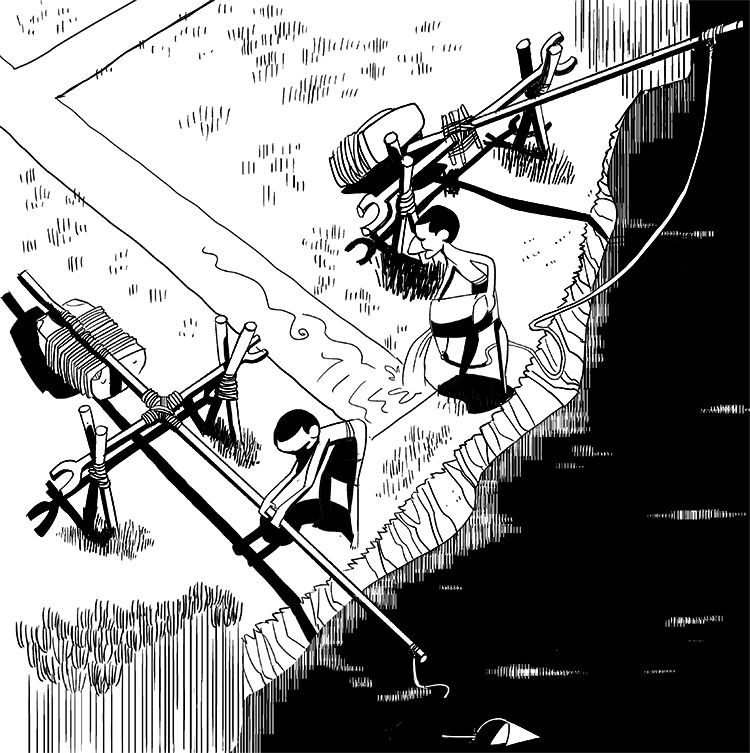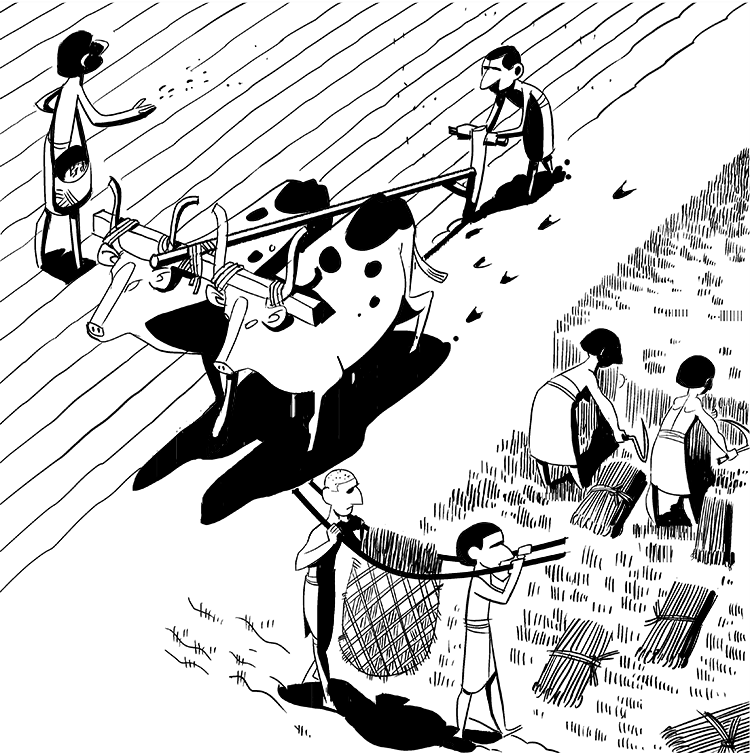No farms, no food!
In modern times, this is a bumper sticker people put on their cars to support agriculture and the conservation of farmland. But it’s also a reminder of how farms and farming make up the foundation of all civilization.
The people living along the banks of the Nile River — who later became the Egyptians — were some of the world’s first farmers, and they were also some of the best.
They used a combination of skill and rich resources to grow their civilization, and in doing so, they developed a deep connection to nature that helped define their culture and society.

The Fertile Lands of the Nile River
Let’s get one thing out of the way: the Egyptians were extremely lucky.
The Nile River, the world’s longest, runs straight through the Sahara Desert, which is almost entirely void of life. Its banks are oases of green in an otherwise barren, desert wasteland.
That it exists is somewhat of a miracle, but the Nile River delivered another gift besides water: fertile soil.
For plants to grow, they need sunlight, water, and nutrients, which must come from the dirt.
The Nile River would flood once a year, and its waters, which were rich in silt, the term used for these nutrients, would inundate the land around the river.
This not only deposited large quantities of water but it also fertilized the soil. This turned the land adjacent to the Nile River into some of the most productive farmland in the world.
Without having to do much at all except plant and wait, the Egyptians were able to grow grains, mainly wheat and barley, in abundance, as well as all sorts of fruits and veggies. This meant there was always food in Egypt!
In Lower Egypt, the Nile River splits into the Nile Delta. Three main channels bring water and silt to a vast area, creating one giant farm that the Egyptians used to build their civilization and also trade with their neighbors.

Shaduf
The Egyptians invented something called the Shaduf, which was effectively a crane with a bucket at the end that allowed farmers to water their crops from the reservoirs
Flooding and Irrigation
The yearly flooding of the Nile was a momentous event. Melting snow from the mountains of Libya and Sudan would combine with rainwater and rush down towards the Mediterranean Sea.
Without this flood, Egypt as we know it would never have existed. And the Ancient Egyptians were quite aware of this. A good flood was often the focus of prayers and other religious ceremonies.
In a practical sense, the Egyptians knew the flood was their only chance to collect water.
They learned early on to build reservoirs and irrigation channels so that they could gather floodwater and use it throughout drier parts of the year. They also invented something called the shaduf, which was effectively a crane with a bucket at the end that allowed farmers to water their crops from the reservoirs.

Basing Life Around the Flood
Because the flood was such a critical event, much of Ancient Egyptian society was based around it. For example, one of the responsibilities of the pharaoh, the Egyptian ruler, was to make sure the gods remained happy throughout the year so that they would deliver a good flood. No pressure!
The Egyptians also based their concept of time around the flood. They had three seasons. First came Akhet, the Season of the Inundation. Next was Peret, the Season of the Emergence, which referred to the fertile soil that emerged as the floodwaters receded. Last was Shemu, the Season of the Harvest.
Akhet was a time to party. Farmland could be covered by up to six feet (two meters) of water, and so there wasn’t much work that could be done.
So, to make the most of the time, and of course to show the gods their gratitude, they held festivals and other religious ceremonies to celebrate what truly was the foundation of all of life in Ancient Egypt.

The Farmer Class
Over 80 percent of the people in Ancient Egypt were farmers, meaning they were by far the largest social class. Yet they were also on the bottom rung of the social ladder. But this wasn’t such a bad thing.
The Ancient Egyptians knew that farmers were an important part of society, and so they were treated with respect and considered essential to the success of Egypt as a whole.
No one in Ancient Egypt owned any land. It all belonged to the pharaoh. So, everything that was grown also belonged to the pharaoh. But he didn’t just keep it all himself. No one can eat that much!
Instead, as part of duty to maintain the cosmic order and uphold truth and justice in Egypt, the pharaoh took his bounty and distributed it throughout Egypt so that everyone had enough to eat. What a guy!

Using Grain to Grow an Empire
After making sure his own people had enough food, the pharaoh often found himself with extra. Egypt was that productive. So he just threw it all in the freezer and saved it for next year…not!
This was Ancient Egypt, remember, there was no ice nevermind electricity for refrigeration.
Instead, the pharaoh would take this surplus and go shopping. He would reach out to leaders of other kingdoms and offer them what he had in exchange for something good. And since people need food, they were often willing to give up some nice stuff in exchange, such as iron, wood, or precious stones.
For example, the Egyptians loved lapis lazuli, a beautiful blue stone that appears in lots of Egyptian jewelry.
This was a real win-win situation for both parties. The other kingdom got some much needed food, and the pharaoh got something fancy.
Over time, these trade relations helped make Egypt rather rich, and they would use this wealth to expand and create an empire.
So, while the Egyptians may have lucked out by landing in one of the most agriculturally productive places in the world, they used this luck wisely and built one of the most successful civilizations of the ancient world.
Written by Matthew Jones
Illustrated by Pablo Velarde Diaz-Pache
